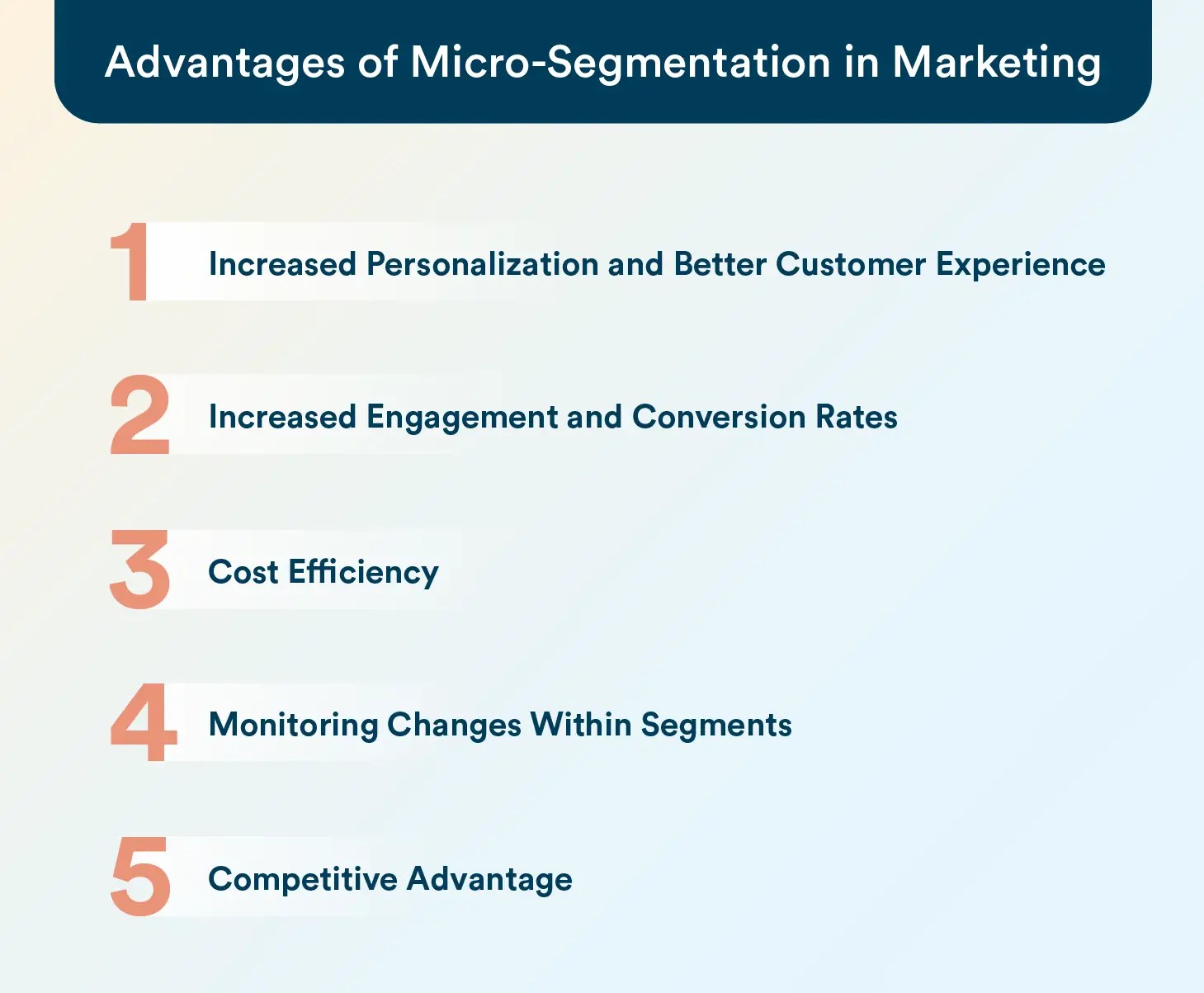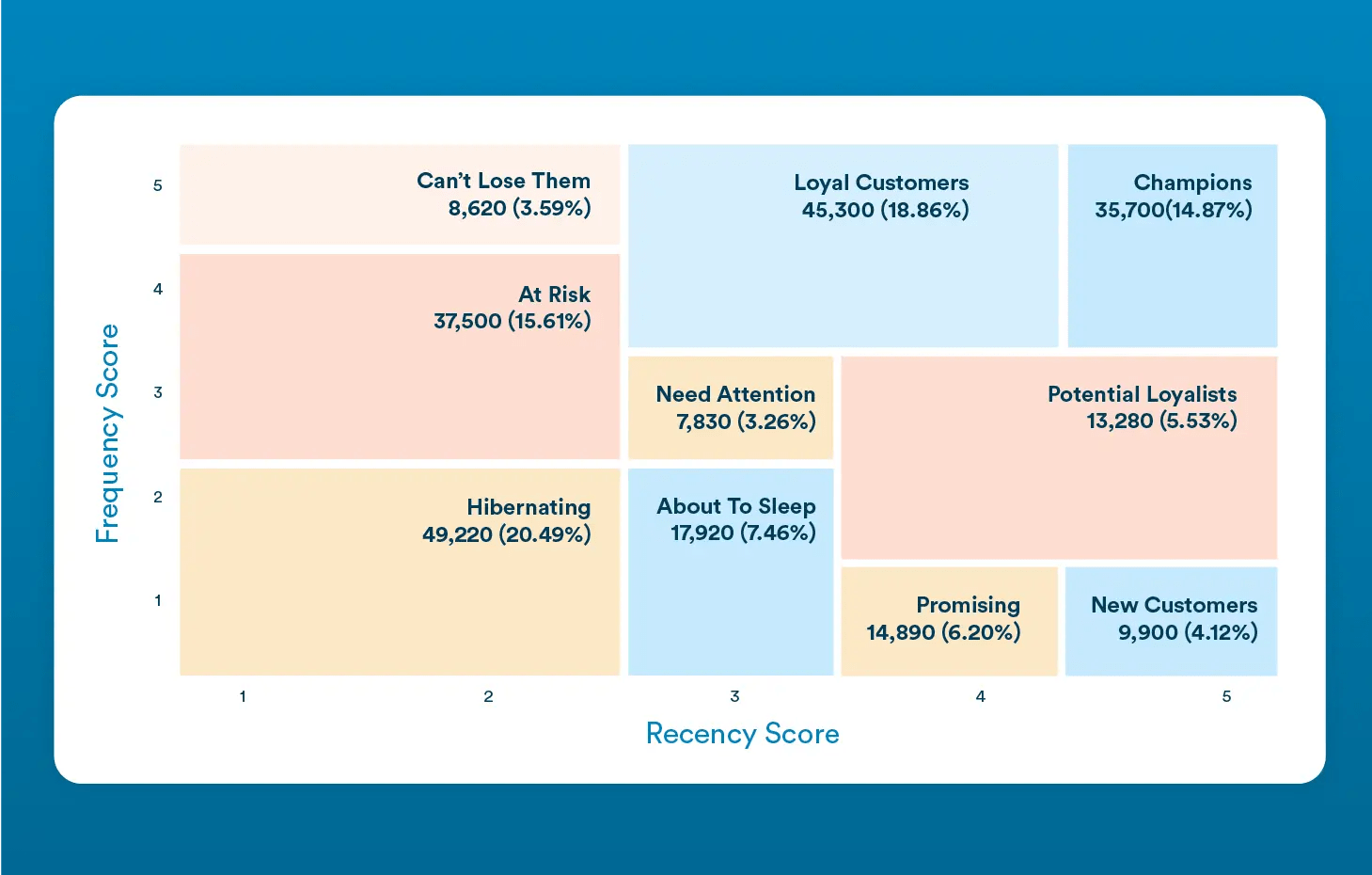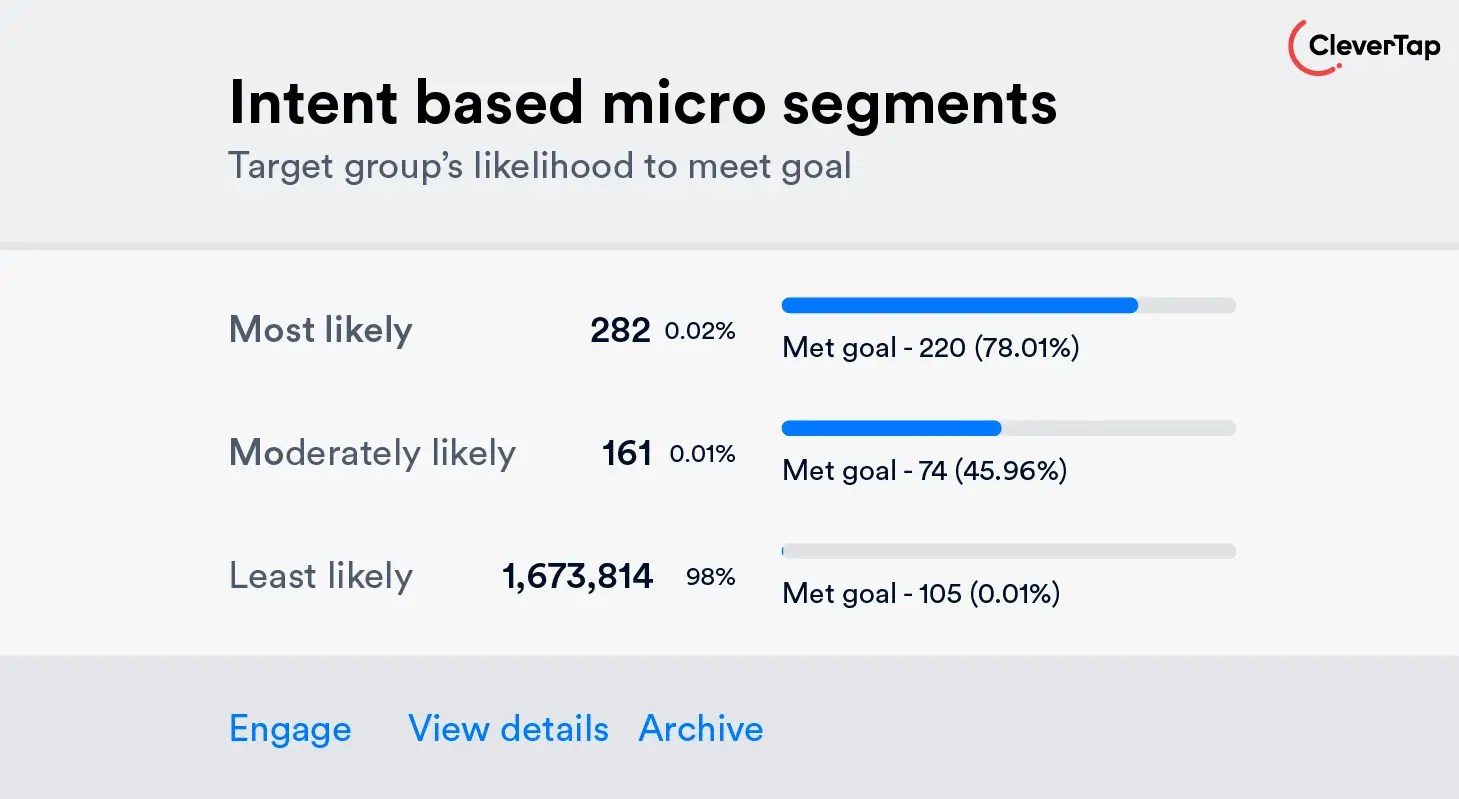Micro-segmentation marketing is a powerful approach that enables businesses to go beyond broad audience targeting to create highly personalized experiences. It helps target customers with precision, increasing engagement and improving conversions.
By using detailed customer data, brands can craft hyper-personalized campaigns that resonate with specific, niche audience segments. This blog explores micro-segmentation marketing, its advantages, implementation strategies, future trends, and more.
What is Micro-Segmentation Marketing?
Micro-segmentation marketing is a way to personalize all campaigns sent to a micro-segment. Micro-segmentation is a highly granular approach to customer segmentation that groups a company’s customer base into a tiny, defined slice to target them with highly relevant and personalized marketing.
Let’s understand this with the help of an example. An e-commerce app can peg a customer as an active app user from the San Francisco Bay Area, between 35 and 50 years old, who is a paying customer that buys home electronics, school supplies, and antiquated 1980s music on CDs, probably has a family with small children, and usually makes a purchase when presented with a discount.
Now, there can probably be scores of app users who fit all the characteristics above, but it would still be a tiny and very niche batch of customers compared to the total user base for that e-commerce app. This is a micro-segment—all sharing similar behavior and characteristics.
The e-commerce app would send this segment free shipping promotions or discount sales via push notification, email, or social media to keep them engaged and active, driving up customer lifetime value. And if it does it well, it will have customers for life.
How Micro-Segmentation Marketing Differs From Traditional Segmentation?
Unlike traditional segmentation, which is used by companies to broadly categorize customers by factors, such as age, gender, location, and income, micro-segmentation marketing delves deeper into behavioral patterns, purchasing history, engagement levels, and psychographics. It enables marketers to create hyper-focused segments for more relevant and personalized campaigns.
Traditional segments are a very general, broader slice of the entire customer base, which is most likely to convert. While this method is useful, it often overlooks the nuances of customer behavior and preferences.
A micro-segment takes from the general bucket of a traditional segment and whittles it down further using machine learning tools and AI-enhanced algorithms such as RFM analysis, and intent-based segmentation. It has three key characteristics:
- Granularity: Instead of targeting a broad audience, marketers focus on niche customer groups with shared characteristics.
- Specificity: Campaigns are tailored based on deep insights into customer preferences, ensuring maximum relevance.
- Dynamic Adjustments: Segments evolve in real time, allowing businesses to respond quickly to shifting consumer behaviors.
The Advantages of Micro-Segmentation in Marketing
Implementing micro-segmentation marketing offers several benefits, including:

1. Increased Personalization and Better Customer Experience
Micro-segmentation marketing enables brands to hyper-personalize their messaging, offers, and product recommendations to a specific micro-segment, which results in stronger customer relationships and higher engagement rates.
For example, an e-commerce platform tracks customer browsing behavior and uses micro-segmentation to suggest products that match their preferences. This increases the likelihood of conversion compared to generic promotions.
2. Increased Engagement and Conversion Rates
By targeting customers with highly relevant content, micro-segmentation marketing significantly improves engagement and conversion rates. A recent study found that emails with personalized subject lines result in a 26% higher open rate and a 760% increase in revenue compared to generic emails.
3. Cost Efficiency
Instead of wasting the marketing budget on mass marketing campaigns, micro-segmentation enables marketers to spend efficiently by focusing on customers who are more likely to convert. For example, a fitness app leverages micro-segmentation to target users based on their workout preferences—such as weightlifting, yoga, or running—and delivers personalized workout plans and promotional offers. This approach optimizes ad spend while improving user retention and lifetime value.
4. Monitoring Changes Within Segments
Micro-segmentation allows businesses to track customer behavior shifts in real time, making it easier to refine marketing efforts. For example, a subscription-based service detects a drop in user engagement within a specific micro-segment and proactively sends a re-engagement email with an exclusive offer, preventing churn.
5. Competitive Advantage
Companies that effectively implement micro-segmentation gain an edge over competitors by offering superior, personalized experiences that differentiate them in the market.
How to Conduct Micro-Segmentation Marketing
To successfully implement micro-segmentation, businesses should follow these key steps:
1. Collect Customer Data
Gather data from various sources such as website analytics, social media, customer surveys, and purchase history to understand customer behavior and preferences. This includes:
- Demographic Data: Age, gender, income, education, etc.
- Geographical Data: Geographic location, typically country, region, or city.
- Behavioral Data: Purchase history, website activity, product preferences.
- Psychographic Data: Interests, lifestyle, personality traits.
Advanced customer relationship management (CRM) systems, data management platforms, and AI-driven marketing tools help aggregate customer data across multiple touchpoints to provide a 360-degree view of customers, enabling marketers to create more precise segments and execute personalized marketing campaigns with greater efficiency.
2. Analyze the Data to Identify Key Segments
Leverage data analytics and AI-powered tools to identify key customer segments based on factors such as demographics, geographic location, browsing behavior, and buying patterns. RFM analysis and intent-based segmentation are two of the widely used micro-segmentation strategies.
Micro-Segmentation Using RFM Analysis
In order to make better use of a micro-segment, you should distinguish where a user is in your customer lifecycle. Recency, Frequency, and Monetary (RFM) analysis is a powerful method that categorizes customers based on:
- Recency: When was the last purchase?
- Frequency: How often do they buy?
- Monetary Value: How much do they spend?
CleverTap’s RFM Analysis helps brands easily pinpoint specific micro-segments based on how often a user launches your app and how much Customer Lifetime Value they bring to the table, such as:
- Champions: Your best customers, who bought recently, purchase often, and are heavy spenders.
- At-Risk Customers: Customers who have purchased often and spent a lot, but have not purchased recently.
- New Customers: Customers who are predicted to become champions but who don’t purchase regularly.

For example, a frequent buyer may simply need to be updated about the latest offerings in your catalog. Meanwhile, a user who has only launched the app once might need a better explanation of the app’s benefits and features so they return to it more often.
Micro-Segmentation Using Intent-Based Segments
Understanding customer intent signals, such as cart abandonment, repeated product views, and more, allows brands to segment users based on buying intent. You can split your audience into micro-segments such as:
- Most likely
- Moderately likely
- Least likely
With these micro-segments, marketers can then take a very clear next step: leaving the “Most likely” alone to buy without expending further marketing resources, and instead focusing campaign efforts on converting the “Least likely” and “Moderately likely” to buy.
CleverTap’s Intent-Based Segmentation makes use of AI-enhanced predictive capabilities to estimate the likelihood that users will achieve a defined goal.
Say you identify a general demographics segment for “users living in New York” and create a goal to “Sell Taylor Swift concert tickets by January 30.” You can use intent-based segments to show how many of your New York-based users are likely to buy tickets.

3. Develop Tailored Marketing Strategies
Once you have identified your micro-segments, create highly targeted content, offers, and promotions that align with each segment’s unique needs and preferences. This could involve personalized email campaigns, dynamic website content, targeted social media ads, and customized product recommendations.
4. Utilize Automation and AI
Marketing automation tools and AI-driven insights help businesses deliver personalized messages efficiently and at scale. Implement real-time marketing automation tools that can adjust messaging dynamically based on user interactions. Chatbots, AI-powered recommendation engines, and programmatic advertising platforms can further enhance micro-segmentation effectiveness.
5. Monitor and Optimize Campaigns
Continuously track performance metrics such as open rates, click-through rates, conversion rates, and customer feedback to measure the effectiveness of your micro-segmentation efforts. A/B testing different messaging strategies can help identify what resonates best with each segment. Use these insights to refine your segmentation approach and optimize your marketing campaigns for better results over time.
Micro-Segmentation Marketing Examples
Let’s look at how some of the leading brands across industries are implementing a micro-segmentation marketing strategy.
1. E-commerce: Amazon’s Personalized Product Recommendations
Amazon uses AI-driven micro-segmentation to analyze browsing and purchase history, offering highly relevant product recommendations to individual customers.
2. Streaming/OTT: Netflix’s Content Suggestions
Netflix leverages micro-segmentation to recommend movies and shows based on a user’s viewing history, improving customer retention and satisfaction.
3. Retail: Sephora’s Loyalty Program
Sephora provides tailored product recommendations and promotions based on customer spending and interests via its Beauty Insider program, enhancing brand loyalty.
4. Education: Coursera’s Personalized Course Suggestions
Coursera provides personalized learning paths based on learners’ past course enrollments, interests, and career goals, making education more engaging and effective.
5. SaaS: HubSpot’s Customized Email Workflows
HubSpot leverages behavioral data to create automated, personalized email workflows for leads and customers, improving engagement and lead nurturing effectiveness.
Future Trends in Micro-Segmentation Marketing
The future of micro-segmentation marketing is evolving with technological advancements. Here are some key trends to watch:
1. AI and Machine Learning
The use of AI and machine learning will continue to enhance micro-segmentation marketing, allowing for proactive marketing interventions and hyper-targeted marketing strategies. Businesses will increasingly leverage AI to analyze vast amounts of data in real time and predict future consumer behaviors and preferences with greater accuracy. These technologies will empower brands to:
- Generate content recommendations dynamically.
- Improve real-time customer engagement based on behavior patterns.
- Create individualized customer journeys, enhancing engagement and brand loyalty.
- Refine their segmentation models, ensuring that marketing campaigns remain relevant and responsive to changing consumer needs.
2. Privacy-Centric Data Collection
With growing concerns about data privacy and regulations like GDPR and CCPA, companies will need to adopt transparent and ethical data collection practices. First-party data strategies, zero-party data collection, and permission-based marketing will gain more prominence.
3. Integration of Omnichannel Strategies
Micro-segmentation marketing will be integrated across multiple channels, including social media, mobile apps, email, and in-store experiences. Businesses will focus on delivering a seamless, consistent experience regardless of where a customer interacts with the brand.
Harnessing Micro-Segmentation Marketing for Long-Term Success
Micro-segmentation marketing is revolutionizing customer engagement by enabling highly targeted, data-driven strategies. By leveraging AI, RFM analysis, and intent-based segmentation, businesses can enhance personalization, improve conversion rates, and maximize marketing efficiency.
To stay competitive, brands must invest in advanced segmentation technologies and integrate them with omnichannel marketing strategies to deliver the ultimate customer experience.
Explore how micro-segmentation marketing can transform your business!
Request Demo
Shivkumar M 
Head Product Launches, Adoption, & Evangelism.Expert in cross channel marketing strategies & platforms.
Free Customer Engagement Guides
Join our newsletter for actionable tips and proven strategies to grow your business and engage your customers.














































